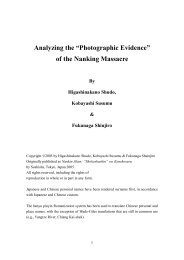The Senkaku Islands Constitute an Intrinsic Part of Japan
The Senkaku Islands Constitute an Intrinsic Part of Japan
The Senkaku Islands Constitute an Intrinsic Part of Japan
Create successful ePaper yourself
Turn your PDF publications into a flip-book with our unique Google optimized e-Paper software.
d<strong>an</strong>gerous conditions. Furthermore, it was impossible for boats to dock, making it<br />
difficult to load/unload people <strong>an</strong>d goods. Koga chartered oce<strong>an</strong>-going fish boats, but the<br />
boats could not go near the shore <strong>an</strong>d had to <strong>an</strong>chor a dist<strong>an</strong>ce from the shore <strong>of</strong> each<br />
isl<strong>an</strong>d. <strong>The</strong>n, multiple round trips were needed between the boat <strong>an</strong>d shore to tr<strong>an</strong>sport<br />
people <strong>an</strong>d goods using small dugout c<strong>an</strong>oes. This was not the only difficulty Koga faced.<br />
In addition, he had to protect the settlers, supply food & shelter, resolve s<strong>an</strong>itation issues,<br />
treat <strong>an</strong>d care for the infirm, rescue people from disaster, <strong>an</strong>d more.<br />
In 1900, Koga went to Tokyo to seek guid<strong>an</strong>ce from Minosaku Jukichi, a doctor <strong>of</strong><br />
science at Tokyo Imperial University. Through Dr. Minosaku‟s referral, Koga met<br />
Miyajima Mikinosuke, who had a bachelor <strong>of</strong> science degree from the same university.<br />
Later, Miyajima would travel to the <strong>Senkaku</strong> <strong>Isl<strong>an</strong>ds</strong> to give Koga field instructions on<br />
civil engineering <strong>an</strong>d other matters. Another advisor to visit the isl<strong>an</strong>ds was Kuroiwa<br />
Tsuneo, a teacher at the Okinawa Normal School. With their assist<strong>an</strong>ce <strong>an</strong>d in<br />
consideration <strong>of</strong> all things, Koga finalized the basic policies <strong>of</strong> development as described<br />
below.<br />
1. Restrict excessive hunting <strong>an</strong>d over-exploitation while making efforts toward<br />
proliferation to protect species from extinction.<br />
2. Build houses to shelter settlers.<br />
3. Build piers for boats to dock <strong>an</strong>d facilitate tr<strong>an</strong>sportation between water <strong>an</strong>d l<strong>an</strong>d.<br />
4. Install catchment t<strong>an</strong>ks on Kuba Isl<strong>an</strong>d, because <strong>of</strong> the isl<strong>an</strong>d‟s lack <strong>of</strong> fresh water<br />
resources.<br />
5. Build roads <strong>an</strong>d construct infrastructure for waste disposal <strong>an</strong>d meet other s<strong>an</strong>itation<br />
requirements.<br />
In line with the policies, civil works were carried out for small port development that<br />
included loading/unloading yards, docks, roads, waste treatment facilities, <strong>an</strong>d dikes.<br />
In 1906, Koga built three bonito fishing boats, hired dozens <strong>of</strong> fishermen <strong>an</strong>d dried<br />
bonito makers from Miyazaki prefecture <strong>an</strong>d ventured into the bonito business.<br />
In 1907, he imported thirty thous<strong>an</strong>d camphor seedlings from Taiw<strong>an</strong> to pl<strong>an</strong>t on<br />
Uotsuri <strong>an</strong>d Kuba. <strong>The</strong>y grew successfully.<br />
From 1905 onward, he launched a taxidermy business for stuffed noddies, brown<br />
boobies, <strong>an</strong>d other waterfowl targeting sales to the Yokohama <strong>an</strong>d Kobe areas. <strong>The</strong><br />
business boomed <strong>an</strong>d export volumes totaled 200,000 birds in 1907 <strong>an</strong>d 400,000 birds in<br />
1908.<br />
As the years passed through the Meiji, Taisho, <strong>an</strong>d Showa eras, the Koga family<br />
engaged in m<strong>an</strong>y industries in the isl<strong>an</strong>ds including the following.<br />
1. Gathering bird feathers, stuffing waterfowl<br />
2. Gathering fish (mainly shark fins), seaweeds, seashells, <strong>an</strong>d turtle shells<br />
3. Fishing bonito, m<strong>an</strong>ufacturing dried bonito for broth<br />
4. Forestry<br />
5. Cultivating fields<br />
8












